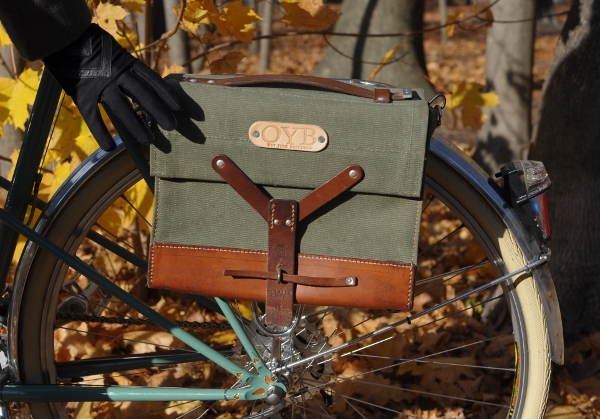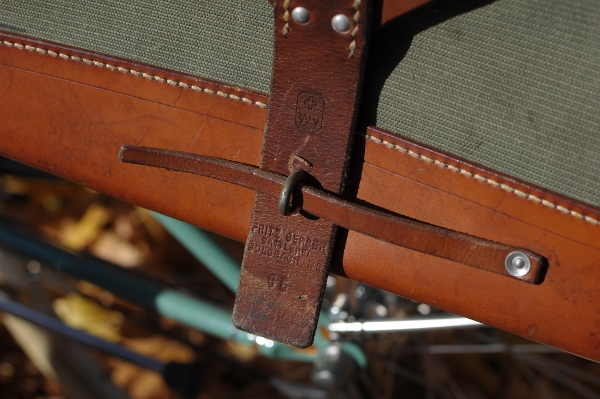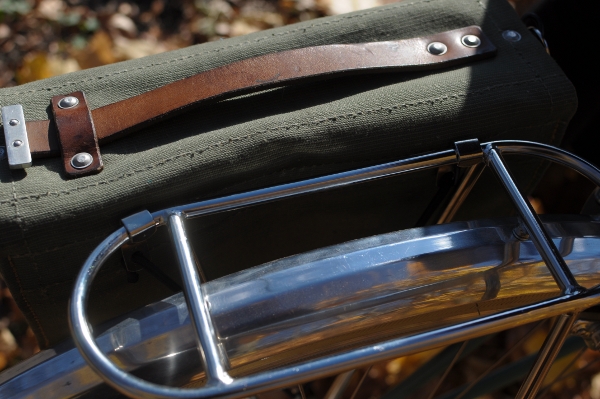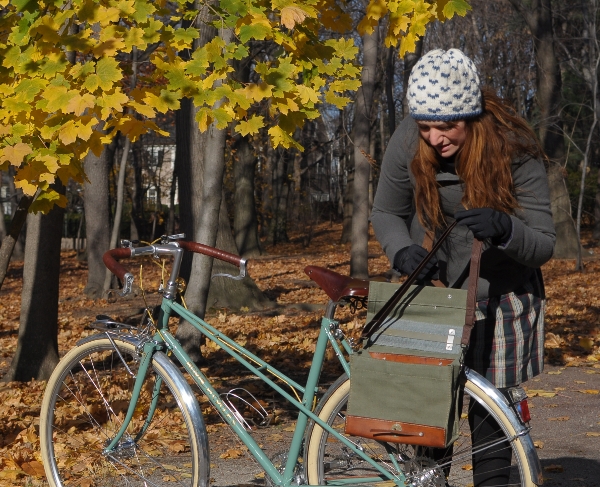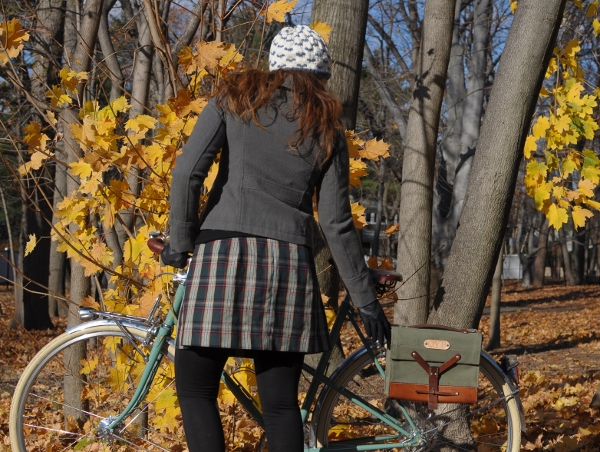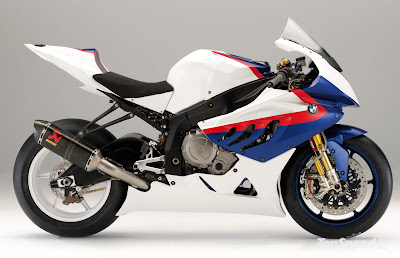Nice bike CB 1300 F wallpapers
Tuesday, November 30, 2010
What Our Hands Can Do
Looking over these photos from the Friday after Thanksgiving, I noticed something interesting: Almost everything pictured here is hand-made. The dress I am wearing was made by my mother. The hat and scarf were made by me. Even the bicycle was hand-made by an Italian frame builder for Bella Ciao. This combination was not intentional, but once I noticed it, I found it striking.
My mother knitted this elaborate wool dress for herself in the early 1980s and wore it all through her 20s and 30s, after which point she gave it to me. The dress suited her much better, but that has not stopped me from wearing it since I were a teenager. It only occurred to me recently how remarkable it is for a dress like this to survive being worn for three decades by two different women - neither of whom are at all gentle with their clothing. And yet here it is, still looking fresh and current. The tailoring, the textural variation, and the attention to detail are incredible by today's standards - and my mother made tons of this stuff when I was a child, while being a busy career woman, too. (I remember seeing her knit while speaking on the phone and reading a book about mathematics at the same time... )
While my own attempts at knitting are fairly pedestrian compared to my mother's past projects, they do have one feature in common: longevity. I knitted this scarf back in grad school, and 8 years later it remains alive and well, while countless store-bought ones have since fallen apart. My friends, for whom I've made clothing as far back as high school, give me the same feedback - some of them still wear the things I made in the mid-'90s. Noticing this was a big reason why I started to knit and sew again this year: I am not that great at it, but the stuff I make lasts and fits me better than store-bought.
Over this past year I have done something a little nuts: I've sold or given away most of my clothing - stuff that I had collected and saved for more than 10 years. When I was younger, I was into edgy fashion and quirky designers, but lately that interest has all but faded - replaced by a curiosity regarding how far I can go making things on my own. Aside from knitting, I have been cutting up some of my remaining old clothing and handsewing "new" clothes out of it. Hopefully I will get a sewing machine for the holidays, which will allow me to take things further. In the past I have dabbled in making my own fountain pens as well. And eventually - maybe, just maybe, I would like to try my hand at building bicycle frames - or at least designing them à la Grant Petersen.
While my framebuilding days are not yet on the horizon, I do have enormous respect for bicycles hand-made by others, and an insatiable curiosity about the process. Whether independent framebuilders such as JP Weigle, Peter Mooney, Royal H. and ANT, or small manufacturers such as Mercian, Rivendell, Velo Orange and even Pashley and Bella Ciao - I am impressed by the sheer amount of work and consideration it takes to get the design, the construction, and the finishing just right. The more I learn about the process, the more overwhelming it seems. In a world of homogenous, mass-produced goods, it is amazing to witness what our minds and our hands are capable of creating.
Labels:
Bella Ciao,
Clothing,
frame building,
skirt,
social commentary
Monday, November 29, 2010
Colin's c1933 596cc Model 30 Norton
Sent by Colin in Australia
JdK: another 596cc Model 30! Compare this Norton to Ballazam's Model 30 and Thierry's engine. None of these Nortons have identification numbers in the frame or crankcase.
Simon: It it obviously fairly early as it still has a Sturmey Archer gearbox and Best and Lloyd filler caps. Also note the studs on the tank to take George Dance kneegrips and the inverted lever for the valve lifter - all pointers to it being - originally - '32/'33 -ish. It has a Mosely inflatable 'bum-pad' and down draught carb. The forks are strutted and I've never seen strutted Norton (as opposed to Webbs/Druids) forks before but the struts may be bolt on jobs - not easy to see one way or the other...
"This outfit was bought by me in about 1964, from one Joe Vial, who ran a wrecker’s yard specialising in early Jaguar cars at Blackburn, Melbourne, Australia. The bike was tucked away in a corner of the yard covered with the bonnet of a Standard ‘Vanguard’ and numerous waterlogged potato bags. It appeared that Joe’s brother had cleared out his garage and the outfit had been dumped in the yard – probably because it was closer than the tip. When found, the Norton was fitted with a narrow 1930’s-period racing sidecar, rather like a ballet shoe in contour. The sidecar is built up on the basic frame of a lightweight Goulding touring ‘chair’. The most notable things about the bike on casual inspection were the crankcase, rather roughly cast in bronze (!), and the faded legend “Norton 596” painted on the sidecar nose. When, on discovering it, I asked Joe about the bike, he described it as an ‘Oily Manx’, essentially a prototype, that later evolved into the single OHC ‘International’ sports machine and the twin-cam ‘Manx’ of racing fame through the 1950’s, 60’s etc. The crankcase has no identification and there is no frame number either!
Joe and his brother had raced it in Victoria, mainly fitted with the side-car, prior to World War Two. It had ‘blown up’ in 1939, and had been re-built. It was being run-in when war broke out and was not used again. It's claim to fame, according to Joe, was that it held the record for the long defunct Whittlesea hill climb.
I coveted the machine from the outset, but being in the ‘impoverished student’ category, couldn’t afford the £50 Joe demanded for it. I went around to the yard from time to time for car parts and checked up on it whenever I was there. The price went down to £45 after a time, but that didn’t really help me much. Finally, during one visit Joe told me, with a sort of morose satisfaction, that one night, a week or so before, someone had tried to steal the bike. They had dragged it to the corrugated iron fence of the yard, but apparently found it too heavy to lift over. The evil-doers (or at least evil-attempters) then tried to take off the carburettor and magneto. Fortunately, as both are rare period racing items (a BTH magneto and an Amac twin float chamber carburettor), they could not get them off with the pair of pliers and screwdriver which seemed to be their only tools. All that was actually stolen was the fuel lines and magneto chain cover (bastards!).
Now this episode thoroughly scared me, and I immediately came to the conclusion that the motorcycle was actually more desirable than three meals a day, so I bought it for £45. It came with a box containing a set of engine shaft sprockets and a selection of alcohol jets for the carburettor, together with a spare high compression piston and a few other odds and ends. In order to get it from the wreckers yard to where I lived four or five miles across town, I enlisted the help of a student friend with a car to tow me on the equipage. Being towed through Melbourne suburban Saturday afternoon traffic on a sidecar outfit with only one grabbing brake and the chair hovering in mid-air on its dirt-track camber was something of a defining experience in my life – it brought home a profound conviction of my own mortality.
According to Joe a rough factory manual with tuning and gear ratio recommendations was around somewhere; he thought his brother still had it. At that stage I was leaving Melbourne for a couple of months, so I arranged to pick up the manual from Joe on my return. When I went around to the yard next, not only was the manual not there, but the whole yard had disappeared and a housing estate was going up. Despite extensive detective work I never located Joe or his brother.
Various explanations have been offered for the bronze/brass crankcase, but no definite explanation has emerged – It may have been part of the 1939 rebuild, but looked far more weathered than short running-in sessions would explain. Presumably the extra strength of bronze over aluminium justified the awe-inspiring weight of the unit. Alan Bruce and some of the old-time riders in Europe became very excited when they heard of it, saying that Norton had built a couple of bronze-crankcase 596’s in the 1930’s for an attack on records on Brooklands and this could well be one of them. So far we have not been able to confirm this. The frame seems to be heavier gauge than a standard Norton 500 and has exceptionally low ground clearance, as if it were designed specifically for side-car racing.
It has been very difficult to get much information about this machine. Roy Bacon, in his book “Norton Singles” makes a short mention on page 47 of a Norton 596cc OHC “Big Banger”, observing that: ‘few were built, all intended for sidecar use’. A handful of iron head, single-cam versions were built, said to be intended for a British ISDT team. This example has an iron cylinder head. Apparently a few did escape from their British captivity; early photographs of Victorian and South Australian competition indicate that probably two made it to Australia. Judging from some early photographs, this may be the ‘596’ raced by Laurie Wren of Adelaide earlier in its life."
JdK: another 596cc Model 30! Compare this Norton to Ballazam's Model 30 and Thierry's engine. None of these Nortons have identification numbers in the frame or crankcase.
Simon: It it obviously fairly early as it still has a Sturmey Archer gearbox and Best and Lloyd filler caps. Also note the studs on the tank to take George Dance kneegrips and the inverted lever for the valve lifter - all pointers to it being - originally - '32/'33 -ish. It has a Mosely inflatable 'bum-pad' and down draught carb. The forks are strutted and I've never seen strutted Norton (as opposed to Webbs/Druids) forks before but the struts may be bolt on jobs - not easy to see one way or the other...
"This outfit was bought by me in about 1964, from one Joe Vial, who ran a wrecker’s yard specialising in early Jaguar cars at Blackburn, Melbourne, Australia. The bike was tucked away in a corner of the yard covered with the bonnet of a Standard ‘Vanguard’ and numerous waterlogged potato bags. It appeared that Joe’s brother had cleared out his garage and the outfit had been dumped in the yard – probably because it was closer than the tip. When found, the Norton was fitted with a narrow 1930’s-period racing sidecar, rather like a ballet shoe in contour. The sidecar is built up on the basic frame of a lightweight Goulding touring ‘chair’. The most notable things about the bike on casual inspection were the crankcase, rather roughly cast in bronze (!), and the faded legend “Norton 596” painted on the sidecar nose. When, on discovering it, I asked Joe about the bike, he described it as an ‘Oily Manx’, essentially a prototype, that later evolved into the single OHC ‘International’ sports machine and the twin-cam ‘Manx’ of racing fame through the 1950’s, 60’s etc. The crankcase has no identification and there is no frame number either!
Joe and his brother had raced it in Victoria, mainly fitted with the side-car, prior to World War Two. It had ‘blown up’ in 1939, and had been re-built. It was being run-in when war broke out and was not used again. It's claim to fame, according to Joe, was that it held the record for the long defunct Whittlesea hill climb.
I coveted the machine from the outset, but being in the ‘impoverished student’ category, couldn’t afford the £50 Joe demanded for it. I went around to the yard from time to time for car parts and checked up on it whenever I was there. The price went down to £45 after a time, but that didn’t really help me much. Finally, during one visit Joe told me, with a sort of morose satisfaction, that one night, a week or so before, someone had tried to steal the bike. They had dragged it to the corrugated iron fence of the yard, but apparently found it too heavy to lift over. The evil-doers (or at least evil-attempters) then tried to take off the carburettor and magneto. Fortunately, as both are rare period racing items (a BTH magneto and an Amac twin float chamber carburettor), they could not get them off with the pair of pliers and screwdriver which seemed to be their only tools. All that was actually stolen was the fuel lines and magneto chain cover (bastards!).
Now this episode thoroughly scared me, and I immediately came to the conclusion that the motorcycle was actually more desirable than three meals a day, so I bought it for £45. It came with a box containing a set of engine shaft sprockets and a selection of alcohol jets for the carburettor, together with a spare high compression piston and a few other odds and ends. In order to get it from the wreckers yard to where I lived four or five miles across town, I enlisted the help of a student friend with a car to tow me on the equipage. Being towed through Melbourne suburban Saturday afternoon traffic on a sidecar outfit with only one grabbing brake and the chair hovering in mid-air on its dirt-track camber was something of a defining experience in my life – it brought home a profound conviction of my own mortality.
According to Joe a rough factory manual with tuning and gear ratio recommendations was around somewhere; he thought his brother still had it. At that stage I was leaving Melbourne for a couple of months, so I arranged to pick up the manual from Joe on my return. When I went around to the yard next, not only was the manual not there, but the whole yard had disappeared and a housing estate was going up. Despite extensive detective work I never located Joe or his brother.
Various explanations have been offered for the bronze/brass crankcase, but no definite explanation has emerged – It may have been part of the 1939 rebuild, but looked far more weathered than short running-in sessions would explain. Presumably the extra strength of bronze over aluminium justified the awe-inspiring weight of the unit. Alan Bruce and some of the old-time riders in Europe became very excited when they heard of it, saying that Norton had built a couple of bronze-crankcase 596’s in the 1930’s for an attack on records on Brooklands and this could well be one of them. So far we have not been able to confirm this. The frame seems to be heavier gauge than a standard Norton 500 and has exceptionally low ground clearance, as if it were designed specifically for side-car racing.
It has been very difficult to get much information about this machine. Roy Bacon, in his book “Norton Singles” makes a short mention on page 47 of a Norton 596cc OHC “Big Banger”, observing that: ‘few were built, all intended for sidecar use’. A handful of iron head, single-cam versions were built, said to be intended for a British ISDT team. This example has an iron cylinder head. Apparently a few did escape from their British captivity; early photographs of Victorian and South Australian competition indicate that probably two made it to Australia. Judging from some early photographs, this may be the ‘596’ raced by Laurie Wren of Adelaide earlier in its life."
Labels:
1933,
Model 30 596cc
OYB Pannier: a Modified Swiss Army Bag for Your Bike
The OYB Pannier is a small Swiss army surplus bag, modified via the addition of rack attachments and other features by Jeff Potter - the owner and author of the project Out Your Backdoor ("indie outdoor lore and more"). I purchased this bag as a smaller alternative to the enormous shopper pannier I normally use. My criteria were durability, classic aesthetics, a trustworthy attachment system, a reasonable price, and a size just large enough to snugly fit my medium format camera equipment or my (very small) laptop. While I am aware that these same bags (without the bike-ready modifications) can be purchased from several other sources, I opted for the OYB version because I wanted the modifications to be made by someone with experience and because I wanted to support the "Out Your Backdoor" project, which provides some great resources for its readers.
Compact and boxy, the pannier is a Swiss military bag made of a thick, stiff, olive-green waxed canvas with brown leather trim and steel rivets. The OYB leather patch is a lighter shade than the rest of the leather on the bag, but this can easily be changed with a modest application of neatsfoot oil or even Proofide. I am not sure whether this particular bag started out as new-old-stock, or whether it had been used in its previous life, but to me it looks more like the former. The condition is better than I had expected based on the pictures and product description on OYB.
The closure system is simple and secure: That very stiff leather cord pulls out of the metal loop, and the thick leather strap lifts up off the loop to open the bag. For those curious, the imprint on the leather reads "Fritz Gerber Sattlerei, Goldbach."
Here is a close-up of the metal hooks. They are riveted on to the bag.
And here is a close-up of the bungee attachment. Together, these two attachment points ensure that the pannier does not sway or bounce against the rack - a good feature when you are planning to carry camera equipment. When the bag is not being used as a pannier, the bungee hook attaches to that small leather strip you see on the back of the bag - so that it does not hang loose. [Edited to add: I am now told that the bungee cord is supposed to go through that leather loop before you hook it to the bottom of the rack - oops.]
In addition to the rack attachments, the OYB pannier can be ordered with a number of other optional features, including shoulder strap attachments with a removable shoulder strap. I asked for the strap, because I pan to carry the bag around when off the bike, and this set-up essentially this gives me a camera bag and pannier in one. Other options include lights mounts, and a variety of other attachments.
To give you a sense of scale, here is the pannier in relation to me and to the entire bike. It is a small bag. Dimensions are listed as: 8.5" tall, 4" deep, 11.25" wide (5.4 liters). Inside, the length of the bag is listed at 10.75", but I was hoping against hope that it would fit my 8 1/2 x 11" laptop. OYB gives instructions for stretching the bag out with magazines in order to make it fit items of that size, and I will give this a try. If I can get my laptop to fit, I will be thrilled - but I am not getting my hopes up and am prepared to content myself with this being a camera bag only.
If it were not for the laptop fit issue, this would pretty much be my dream pannier. The mil-spec colour scheme is not for everyone, but I love it, and it suits almost all of my bikes nicely. The durability of military surplus items is superb, and I appreciated getting the bag customised by Jeff at OYB. This is a classic, versatile, and reliable little pannier refashioned by someone who loves bicycles.
Compact and boxy, the pannier is a Swiss military bag made of a thick, stiff, olive-green waxed canvas with brown leather trim and steel rivets. The OYB leather patch is a lighter shade than the rest of the leather on the bag, but this can easily be changed with a modest application of neatsfoot oil or even Proofide. I am not sure whether this particular bag started out as new-old-stock, or whether it had been used in its previous life, but to me it looks more like the former. The condition is better than I had expected based on the pictures and product description on OYB.
The closure system is simple and secure: That very stiff leather cord pulls out of the metal loop, and the thick leather strap lifts up off the loop to open the bag. For those curious, the imprint on the leather reads "Fritz Gerber Sattlerei, Goldbach."
The attachment system is a combination of metal hooks and bungee cords, with which the pannier is secured to the rear rack. The rack I have on this bicycle is the Constructeur rack from Velo Orange, which is quite small.
Here is a close-up of the metal hooks. They are riveted on to the bag.
And here is a close-up of the bungee attachment. Together, these two attachment points ensure that the pannier does not sway or bounce against the rack - a good feature when you are planning to carry camera equipment. When the bag is not being used as a pannier, the bungee hook attaches to that small leather strip you see on the back of the bag - so that it does not hang loose. [Edited to add: I am now told that the bungee cord is supposed to go through that leather loop before you hook it to the bottom of the rack - oops.]
To give you a sense of scale, here is the pannier in relation to me and to the entire bike. It is a small bag. Dimensions are listed as: 8.5" tall, 4" deep, 11.25" wide (5.4 liters). Inside, the length of the bag is listed at 10.75", but I was hoping against hope that it would fit my 8 1/2 x 11" laptop. OYB gives instructions for stretching the bag out with magazines in order to make it fit items of that size, and I will give this a try. If I can get my laptop to fit, I will be thrilled - but I am not getting my hopes up and am prepared to content myself with this being a camera bag only.
If it were not for the laptop fit issue, this would pretty much be my dream pannier. The mil-spec colour scheme is not for everyone, but I love it, and it suits almost all of my bikes nicely. The durability of military surplus items is superb, and I appreciated getting the bag customised by Jeff at OYB. This is a classic, versatile, and reliable little pannier refashioned by someone who loves bicycles.
Labels:
bags,
Constance,
mixte,
product reviews,
skirt
Subscribe to:
Posts (Atom)
Blog Archive
-
▼
2010
(1788)
-
▼
November
(397)
- Nice bike CB 1300 F wallpapers
- Nice bike CB 1300 F wallpapers
- BMW Bikes Wallpapers
- BMW Bikes Wallpapers
- What Our Hands Can Do
- Colin's c1933 596cc Model 30 Norton
- OYB Pannier: a Modified Swiss Army Bag for Your Bike
- BMW S1000RR Gallery
- BMW S1000RR Gallery
- BMW S1000RR Pictures
- BMW S1000RR Pictures
- BMW HP2 Sport
- BMW HP2 Sport
- BMW HP2 Sport Bike
- BMW HP2 Sport Bike
- Yamaha SZ
- Suzuki Slingshot
- Mahindra Stallio
- 2011 KTM RC8R Superbike
- 2011 KTM RC8R Superbike
- Ducati Streetfighter Pictures
- Ducati Streetfighter Pictures
- Modification Bajaj Pulsar Motor Italian Style
- Modification Bajaj Pulsar Motor Italian Style
- American Chopper Modification 2010
- American Chopper Modification 2010
- Yamaha Bison Modifications
- Yamaha Bison Modifications
- New Honda CB1000R (2010) Modifications
- New Honda CB1000R (2010) Modifications
- Yamaha FZ16 India Review
- Yamaha FZ16 India Review
- Suzuki V Strom 650 Spec and Price
- Suzuki V Strom 650 Spec and Price
- Honda RC212V New Model Motorcycleh
- Honda RC212V New Model Motorcycleh
- Winter Hibernators
- Thierry's 596cc Model 30 engine
- Announcing Hat Recipient!
- Husqvarna at Motorcycle Live
- Polar Bear Grand Tour to Port Jervis, NY on Nov. 2...
- Motorcycle Pictures of the Week - Tom
- Musings on MUSA Knickers
- 2006 Honda CBR 600 F4i
- 2006 Honda CBR 600 F4i
- sexy motorcycle wallpapers
- sexy motorcycle wallpapers
- sexy motorcycles
- sexy motorcycles
- New Yamaha Star Stryker Chopper Style
- New Yamaha Star Stryker Chopper Style
- Best Honda Motorcycle Modification
- Best Honda Motorcycle Modification
- Easy Motorcycle Financing - Are Bad Credit Motorcy...
- Easy Motorcycle Financing - Are Bad Credit Motorcy...
- Benelli celebrate a Century with the Century Racer...
- See the MV Agusta F3 at Motorcycle Live
- c1932 Model 19 Norton
- Fade to Black
- Unique Motorcycle Helmets
- Unique Motorcycle Helmets
- 2010 Honda CBR Leyla
- 2010 Honda CBR Leyla
- Side valve racer
- Happy Thanksgiving 2010 !
- Fresh New Look for 2011 Corsa
- C W G Lacey on his 1930 588cc Norton
- The 'Thanking Your Bicycle' Give-Away!
- 2010 Motorcycles from Honda
- 2010 Motorcycles from Honda
- 2010 Honda VFR 1200F Review
- 2010 Honda VFR 1200F Review
- SUZUKI G-Strider Concept Motorcycle
- SUZUKI G-Strider Concept Motorcycle
- Advice from Fixed Gear Experts? And a Look at MKS ...
- Big Motorcycles Extreme Modification
- Big Motorcycles Extreme Modification
- Derbi Mulhacen 125 Wallpapers
- Derbi Mulhacen 125 Wallpapers
- Blue Motorcycle
- Electric Motorcycle
- Triumph launches many new models.
- Colour Theory for Bikes
- Kawasaki ZX-R 2010
- Kawasaki ZX-R 2010
- Motorcycle Superstore
- Motorcycle Superstore
- Sexy Girl and Fast Motorcycle
- Sexy Girl and Fast Motorcycle
- Ducati 1098 Motorsport
- Ducati 1098 Motorsport
- Suzuki GSX R-1000 Photo
- Suzuki GSX R-1000 Photo
- Moto Guzzi 1200 Sport Bikes
- Moto Guzzi 1200 Sport Bikes
- MV Agusta F4 RR 312 Motorsport
- MV Agusta F4 RR 312 Motorsport
- Ducati Street Fighter Sport Bikes
- Ducati Street Fighter Sport Bikes
- Cagiva Mito 125 Motorsport
-
▼
November
(397)















